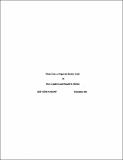| dc.contributor.author | Joskow, Paul L. | en_US |
| dc.contributor.author | Marron, Donald B. | en_US |
| dc.date.accessioned | 2009-12-15T17:55:33Z | |
| dc.date.available | 2009-12-15T17:55:33Z | |
| dc.date.issued | 1991 | en_US |
| dc.identifier | 91-016 | en_US |
| dc.description.abstract | We use data from ten utility conservation programs to calculate the cost per kWh of electricity saved -- the cost of a "negawatthour" -- resulting from these programs. We first compute the life-cycle cost per kWh saved based on utility experience and expectations associated with these conservation programs. The resulting figures indicate that the cost of a negawatthour is substantially higher than previously suggested by standard sources such as Lovins and EPRI which are routinely cited by policymakers. The costs calculated for residential programs in particular are much higher than conservation advocates have suggested. We find substantial variation in costs for similar programs between utilities as well as significant intro-utility variation in the cost per kWh saved for specific sub-programs. Some of these programs appear to be uneconomical even before correcting for biases in utility cost accounting and in the measurement of actual electricity savings. | en_US |
| dc.description.abstract | The bulk of the expenditures and savings from the utility conservation programs we reviewed are associated with subsidies for commercial and industrial conservation investments rather than for conservation investments made by residential customers. furthermore, it is likely that the values for the cost per kWh saved that we derive from utility reports understate their true costs by a factor of two or more on average. The actual costs per kWh saved are likely to be significantly higher, on average, than those computed from utility reports because utilities frequently fail to count important cost elements. They also frequently fail to base their estimates of the electricity saved by the programs on ex post measurement of consumer behavior, relying instead on notoriously inaccurate ex ante engineering estimates. | en_US |
| dc.description.abstract | Better utility cost accounting procedures and the development and use of sound sampling and statistical methods to measure the electricity savings actually achieved by utility conservation efforts is essential to ensure that only cost-effective conservation programs are pursued and to protect electricity ratepayers from excessive costs. | en_US |
| dc.format.extent | 58, 2 p | en_US |
| dc.publisher | MIT Center for Energy and Environmental Policy Research | en_US |
| dc.relation.ispartofseries | Working paper (Massachusetts Institute of Technology. Center for Energy Policy Research) ; MIT-CEPR 91-016. | en_US |
| dc.title | What does a negawatt really cost? | en_US |
| dc.type | Working Paper | en_US |
| dc.identifier.oclc | 26507452 | en_US |
